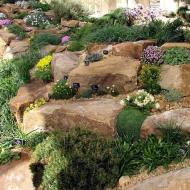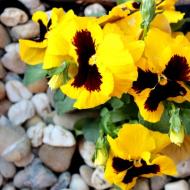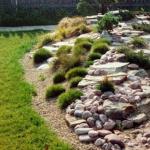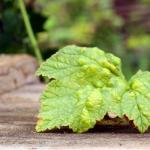
How to make an alpine slide in the country with your own hands?
Editor Rock garden and rockery 3963
Blooming from early spring to late autumn, the alpine slide is a gardener's pride and trouble. Beauty revived with one's own hands seems simple and natural, but behind this is labor multiplied by creativity. The more natural the alpine slide looks in the country, the more effort was put into it by its creator.
The idea of creating a corner of wildlife in the country is very tempting. The ideal composition is a combination of stones and plants. Well-chosen variations resemble a mountain landscape. There are certain rules for arranging alpine slides with your own hands, but this only applies to laying technology. The visible upper part is the process of personal creativity. The gardener can rely on recommendations, however, he will receive only his final result. There are no two similar alpine slides. It is always a manifestation of individuality. The presence of one or more large stones is a prerequisite for the composition. This emphasizes the desire to resemble a mountain peak. Country hill is no more than two meters high. The slopes are planted with low-growing evergreens and seasonally flowering plants.
The main misconception of novice gardeners is the idea that a pile of stones, half covered with fertile soil and covered with a vegetable carpet, can already claim the title of an alpine hill. I would like to emphasize once again that making an organic composition with your own hands is a creative, time-consuming process associated with financial costs.

The rock garden has a history
The mention of the Alps suggests that the idea was born to create a mountain landscape in the garden somewhere in Europe. But it's not. The Japanese are considered to be the founders of stone gardens. It was they who discovered to the world the art of combining the hardness of stone with the tenderness of flowers. Spectacular rock gardens on the distant islands of the Rising Sun are known and described thousands of years ago. This idea came to civilized Europe in the 16th century, and to Russia only in the 18th century.
What is rockery?
Rockery is a composition of stones and plants, where hard rock plays the main role, and herbs and flowers serve as a background. Only one type of stone is used here. They are arranged randomly or folded with their own hands in parallel rows into low walls. There is an illusion of a rocky mountain environment.
Plants play the main role in rock gardens. It is their beauty among the stones that attracts the eye.
You should not confuse these concepts and know what exactly you want: rock garden or rockery.

The main green components of the rock garden
Feature for all herbs and flowers:
- unpretentiousness in care;
- short stature;
- survivability in adverse conditions: with excess water and in case of drought.
You can change the image of the flower bed every year by planting annuals with your own hands. But it is better to immediately focus on perennial specimens. Then every year the appearance will become more attractive. You should take into account the seasonality of flowering of each inhabitant of the flower bed and pick up a variety of specimens.
In the natural environment, there are several representatives of the wild flora, which have long been cultivated as garden plants.

For an alpine slide fit:
- edelweiss; a romantic symbol of love that overcomes all obstacles; frost-resistant perennial; spreads on the ground with small rugs; flowering season - early and mid-summer;
- rejuvenated or stone rose; flower with earthy fleshy leaves; grows rapidly between stones; light purple flowers; resistant to any weather changes;
- lumbago; small perennial from the buttercup family; blooms the very first; grows well;
- stonecrop; represented by several varieties; perfectly spreads along the ground with creeping stems, destroys weeds around it; changes color under the influence of the sun;
- saxifrage; likes northern or shaded slopes; weaves a green flowering rug even over stones;
- crocus; small bulbous stars of a wide variety of colors; bloom from March to May; breed well;
- dwarf barberry; refers to the type of shrubs; creeps on the ground; suitable for the lower tier; in spring it pleases with flowering, in autumn with red berries;
- juniper; evergreen undersized bush; can serve as the center of the composition; unpretentious and stable.
Alpine aster, dwarf barberry, aquilegia are also used; phloxes; Japanese spirea. All plants need time to show themselves in all their glory. Applying multi-tier landings, it will be possible to achieve a better result.
Location selection
It is advisable to define a spacious, well-lit corner for the rock garden. The flowerbed should be visible from all sides. Handmade beauty needs to be shown.
The composition looks more natural in spacious places: in the center of the garden, between the paths, as an independent flower bed. The location in the corner, between the trees and buildings will not allow you to fully show the beauty of creation.
If one of the slopes of the hill is shaded, this is not a reason to be upset. You will have to choose plants for which such conditions are the most comfortable.
Drainage is a necessary procedure for soil health
The nature of the soil must be taken into account. Sandy soil is better and is natural drainage. There will be no problems with excess moisture. For clay soil and clean, oily black soil, a mandatory drainage layer is required from any convenient materials. The work is simple, done by hand.
You can arrange the drainage system around the entire perimeter of the base. If the problem of fluid accumulation is not for your area, it is enough to dig a few holes.
The equipment technology is simple:
- remove a layer of soil to a depth of 30 cm;
- fill up 20 cm of crushed stone or gravel, any small construction waste will do;
- ideally, it is better to cover the drainage with a layer of geosynthetic textiles; it allows water to pass through, but does not allow even the smallest particles of soil to leave with the liquid; separates the layers, does not allow them to mix; subsidence of the soil is excluded;
- then a 10 cm layer of sand is poured;
- layer of earth.
Each part of this cake must be well watered after backfilling.
soil mixture
To form the best natural base, cleaned and sifted earth, coarse sand and dry humus are combined in equal parts.
If this is the first experience at the base of the rock garden, then its height is desirable no more than 1 m.

Stone laying
Three tiers is enough. At the stage of formation of an earthen hill, large specimens are laid in the lower tier so that they look out of the ground.
After that, you need to take a break from work for two weeks. During this time, the soil will settle, compacted. Problem areas will show up.
Then the creative process of laying stones in tiers with your own hands begins. Remember that the natural environment is being formed. Stones should not lie on the surface, but seem to peek out of the ground, forming a single whole with it. There is no need to rush and observe symmetry. Change, move, flip until you get what you like.
The principle of placement of tiers is a pyramid. Small samples should rest securely on the lower large ones. It depends on taste, but it is desirable to select specimens that are uniform in structure and color.
You can draw a diagram of an alpine slide top view. Then it will be easier to do what you want in practice with your own hands.

Top construction
This is the final stage of construction work. There are several options:
- hoist to the top, a massive beautiful stone; it will protect the slide from surface erosion;
- create a mini-pyramid with your own hands with a hollow middle and plant flowers there;
- make a crown of small but attractive samples.
After the completion of construction, it is better to wait a week. Next, proceed to the landing of green inhabitants.
And a few more tips:
- do not use artificial materials, garden sculptures, and unsuitable plants in decorating the slide; the task of obtaining a corner of natural nature should be paramount;
- mountain compositions look great on the edge of lawns;
- it is more convenient to fill the slide with flowers from above;
- fertilizers should be applied in limited quantities, especially when planting; plants must take root on their own; top dressing is necessary after the third year;
- small voids and dips will periodically form; fill them with a mixture of clay soil with peat;
- always water the hill from the foot; impregnated lower layers will not allow soil and microelements to be washed out from above.
















